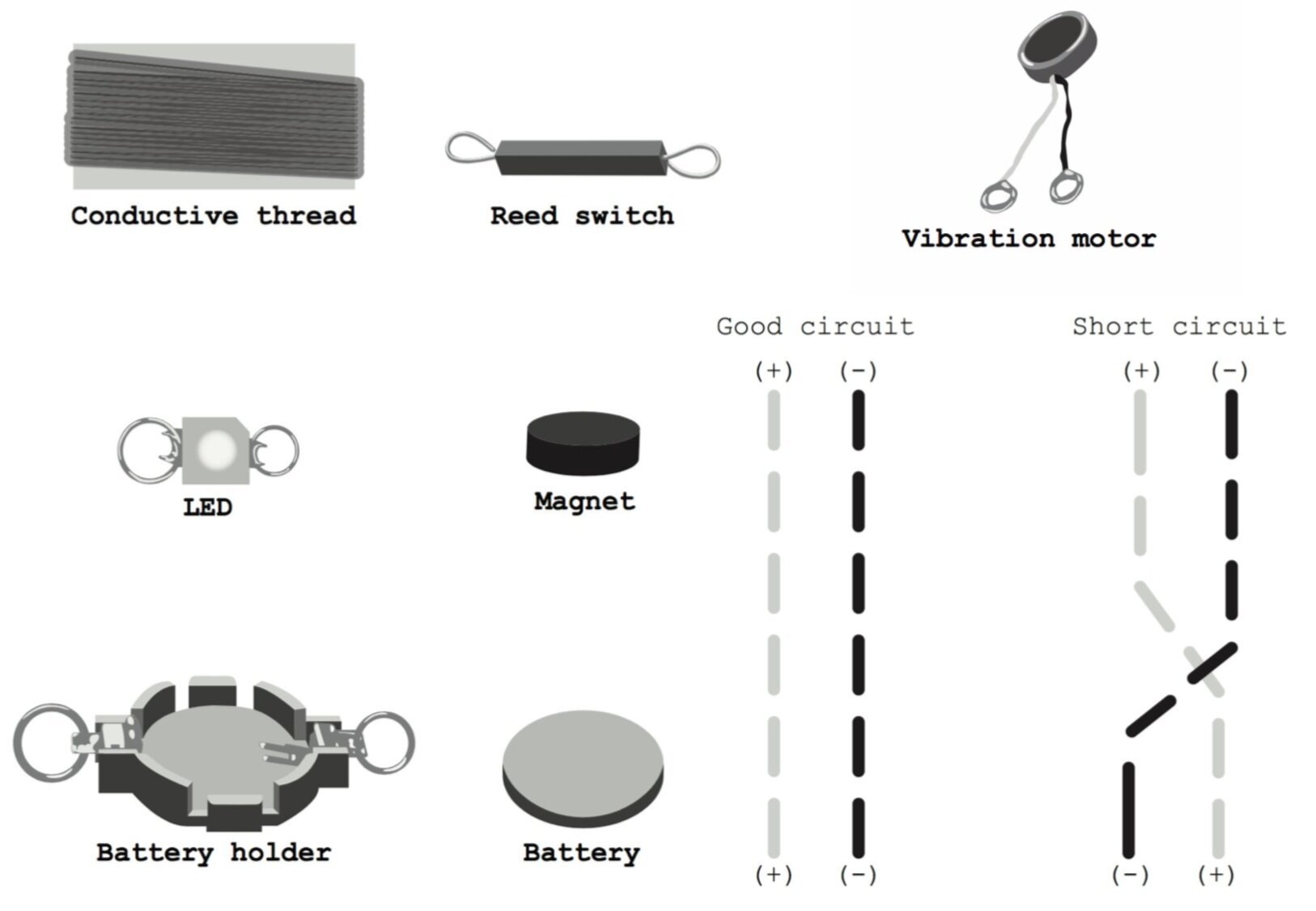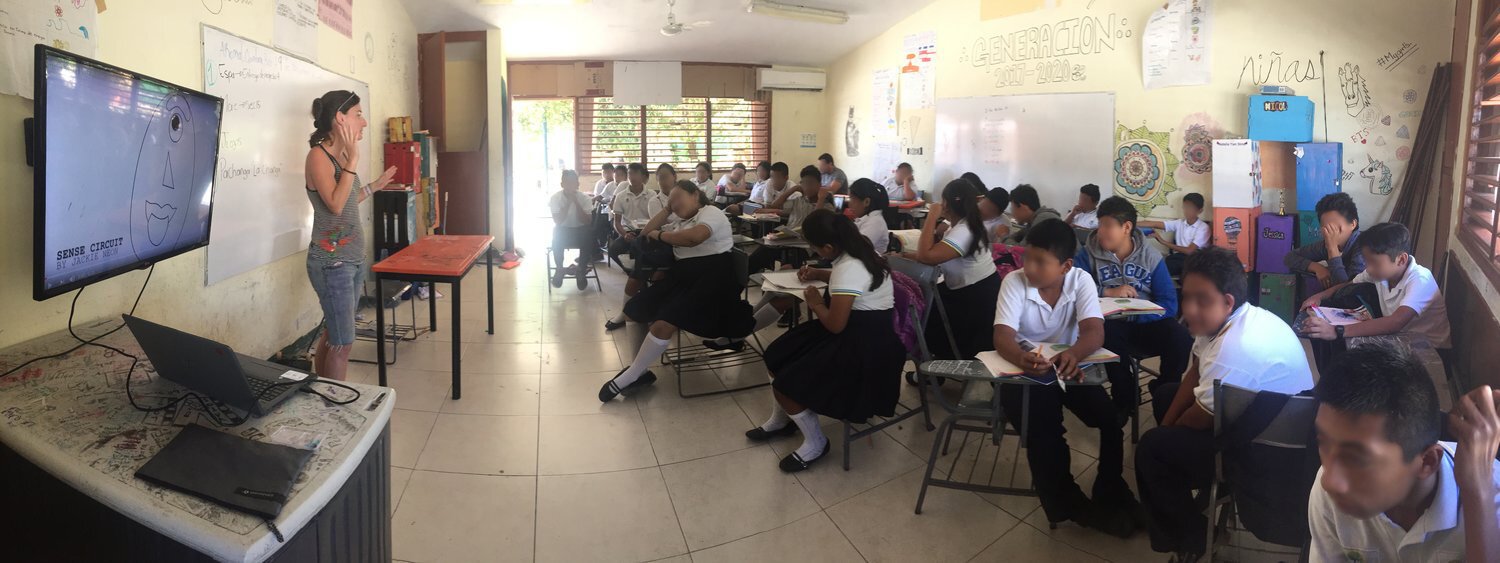Sense Circuit
Yes, you can make an electrical circuit!
Sense Circuit is a Science Technology Engineering Art Math (S.T.E.A.M.) workshop where participants learn how to create a circuit using a conductive thread, a 3V battery, a switch, a magnet, and an L.E.D. or motor. The aim is to demystify creating a circuit and make people who might not feel comfortable making one realize they can. The workshop was free at Creative Tech Week and Maker Fair in New York in English and at The Akumal Arts Festival in Mexico in Spanish. Many projects and products are existing in this area. Little Bits offers beautiful products at a price point that may be out of reach for some. Squishy Circuits provides a range of products and prices with projects for preschool children (aged 3-5 years). Adafruit and Sparkfun also offer a variety of kits and tutorials for learning electronics for people and children of various ages at various price points.
Goal
This work aims to empower people of all ages, regardless of gender and economic standing, to feel they can create circuits or the power to try, be it they "fail" or "succeed." With a market of toys and projects aimed at children and gender inclusion, Sense Circuit creates a space where children and adults can participate regardless of experience level.
Audience
Sense Circuit's audience included:
Children and adults in New York City at Maker Faire and Creative Tech Week.
Visitors of the Akumal Arts Festival in Mexico.
A select group of women at FEMeeting in Portugal.
Role
I was a one-person team creating Sense Circuit. However, participants and friends gave me input on the overall design to iterate. As a one-person team, I was responsible for sourcing and preparing physical materials to create the circuit, making all the informational design material, and creating the workshop.
Scope
One of the most significant constraints for this project was staying true to a miniature budget. The sense circuit's objective was for people to create a course that would cost less than ten dollars in parts. There are several STEAM/STEM products on the market, and many of them have a higher barrier of entry due to cost.
Process
The process for creating Sense Circuit included research into the STEAM/STEM industry, materials, methods, prototyping, and observation of in-person workshops. Materials used for Sense Circuit are electrical components, including battery holder, reed switch, L.E.D., and motor. Participants use a conductive thread to connect the parts and a magnet to activate the reed switch so that power can flow from a 3v battery to turn on an L.E.D. or motor.
Prototyping: Try, Try, Try again.
Initially, this started as an idea to build a wearable toy that two people could play with if they were playing tag. Each one would have a sensor circuit and a magnet. However, this idea did not register well because it left room for error that would discourage participants. The learning objectives were the same: build a circuit using a 3V battery, switch, magnet, L.E.D., and a motor. After a few design tests and the eventual add-on of googly eyes, it became clear that the tag toy was not a driving design. Instead, making something not confined to wearable tech or another person to play with was more fun. Consideration of the construction and materials to make the workshop accessible. Soldering was out of the question to avoid ventilation constraints and lower the barrier of entry. Testing materials were necessary: snaps, conductive tape, and conductive thread and the conductive thread ended up being the winner because it was easier to connect the components as sewing items.
The early workshop had the participants create a circuit using an L.E.D. and a motor, which would later change so that each circuit would either have an L.E.D. or a motor. Creative Tech Week was the first workshop in New York City. The workshop used the L.E.D. and motor as part of the same circuit. A range of people attended the workshop aged 7 to 50. The youngest attendees worked with their parents to create the circuit and needed help and guidance about sewing. Having the motor and L.E.D. on the switch resulted in both working inconsistently due to the resistance from the conductive thread. Future workshops let people choose between making a circuit with an L.E.D. or a motor.
The second workshop at Maker Faire in New York City included children, tweens, and adults. The children who participated in this workshop did not work with their parents; instead, the parents would return after some time, and the children would excitedly show them what they had made and explain how the circuit worked. The following image shows the iteration of the circuit diagram from the original with L.E.D. and motor to the updated version, where each course had an L.E.D. or motor.
The third workshop was part of The Akumal Arts Festival in Akumal, Mexico. I worked to translate the instructions for this workshop, which was in Spanish. The seminars in Mexico were the most prominent groups and some of the youngest attendees because children brought their younger siblings, and it was essential to ensure the children were getting enough support with materials and learning objectives. Some of the older children were able to help with threading needles. The adults who attended the workshop would help knot the threads if the children needed help and I could not get to them quickly. The participants of this workshop were enthusiastic about decorating the final circuit. They were very proud to show off the work they had done. Some people attended the first workshop and made one switch with an L.E.D. and then attended the second workshop to make one with a motor. The most rewarding takeaway from the more prominent groups was seeing the children supporting each other; if one understood the content and saw that another person was struggling, they would help each other. Not only did they do this for the technical knowledge, they also did this for troubleshooting.
Outcomes
The workshops have been well received and welcomed by the communities, leading to many people making fun of excellent switch circuits. The decision to have the circuit use either an L.E.D. or a motor was beneficial because it allowed people to choose and see how similar electronics can be. The ability to sew the circuit together is also positive because it reduces the constraints the workshop would have faced if soldering had been used. The main finding of this work is that people, young and old, who initially felt unable to create a circuit could overcome their insecurities and complete a working circuit. The self-imposed limitation can be confronted and eliminated when people can apply the knowledge they already have to learn new skills.









